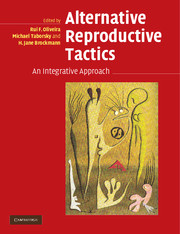Book contents
- Frontmatter
- Contents
- List of contributors
- Preface
- 1 The evolution of alternative reproductive tactics: concepts and questions
- PART I ULTIMATE CAUSES AND ORIGINS OF ALTERNATIVE REPRODUCTIVE TACTICS
- 2 Alternative reproductive tactics and the evolution of alternative allocation phenotypes
- 3 Phylogenetic analysis of alternative reproductive tactics: problems and possibilities
- 4 Modeling alternative mating tactics as dynamic games
- PART II PROXIMATE MECHANISMS OF ALTERNATIVE REPRODUCTIVE TACTICS
- PART III TAXONOMIC REVIEWS OF ALTERNATIVE REPRODUCTIVE TACTICS
- PART IV EMERGING PERSPECTIVES ON ALTERNATIVE REPRODUCTIVE TACTICS
- Index of species
- Subject index
- References
3 - Phylogenetic analysis of alternative reproductive tactics: problems and possibilities
Published online by Cambridge University Press: 10 August 2009
- Frontmatter
- Contents
- List of contributors
- Preface
- 1 The evolution of alternative reproductive tactics: concepts and questions
- PART I ULTIMATE CAUSES AND ORIGINS OF ALTERNATIVE REPRODUCTIVE TACTICS
- 2 Alternative reproductive tactics and the evolution of alternative allocation phenotypes
- 3 Phylogenetic analysis of alternative reproductive tactics: problems and possibilities
- 4 Modeling alternative mating tactics as dynamic games
- PART II PROXIMATE MECHANISMS OF ALTERNATIVE REPRODUCTIVE TACTICS
- PART III TAXONOMIC REVIEWS OF ALTERNATIVE REPRODUCTIVE TACTICS
- PART IV EMERGING PERSPECTIVES ON ALTERNATIVE REPRODUCTIVE TACTICS
- Index of species
- Subject index
- References
Summary
CHAPTER SUMMARY
We present an outline of the potential that a phylogenetic approach may bring to the study of alternative reproductive tactics (ARTs) and discuss some of the difficulties and methodological problems that must be addressed if we are to apply the phylogenetic method successfully. We illustrate the principles presented by applying them to three selected examples. Specifically, based on fish studies, ARTs are, at least in some fish groups, evolutionarily unstable and rarely become incorporated as a fixed trait of a lineage at a rank as high as a family. Despite this instability, it is common for a given lineage to give rise recurrently to very similar forms of ARTs. Our results illustrate the wide spectrum of potential studies that can be enriched by a phylogenetic perspective.
BACKGROUND
The role of phylogenetic studies in the behavioral sciences
When Tinbergen (1963) formulated his famous four levels of explanation in ethology – causation, development, evolution, and function – the study of patterns in the evolution of behavior was explicitly made one of the central aims of the study of animal behavior. Each behavior pattern has an evolutionary history, and often it is possible to trace its origins, identifying the behavior that existed prior to the emergence of the new patterns. The pioneering work of Konrad Lorenz, who used behavior patterns to help to clarify the taxonomy of ducks, illustrates the use of behavioral phylogenies in an outstanding way (Lorenz 1941).
- Type
- Chapter
- Information
- Alternative Reproductive TacticsAn Integrative Approach, pp. 52 - 62Publisher: Cambridge University PressPrint publication year: 2008
References
- 2
- Cited by



